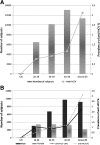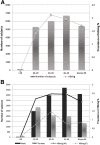Prevalence and risk factors of hepatitis B and C virus infections among the general population and blood donors in Morocco
- PMID: 23331910
- PMCID: PMC3640941
- DOI: 10.1186/1471-2458-13-50
Prevalence and risk factors of hepatitis B and C virus infections among the general population and blood donors in Morocco
Abstract
Background: Viral hepatitis is a serious public health problem affecting billions of people globally. Limited information is available on this issue in Morocco. This cross-sectional study was undertaken with the aim of determining the seroprevalence and risk factors of hepatitis B virus (HBV) and hepatitis C virus (HCV) among the general population and among blood donors.
Methods: Blood samples from volunteers, have been screened with ELISA tests for detecting the hepatitis-B surface antigen (HBsAg) and anti-HCV. Within the seroreactive patients for HCV in the general population, RT-PCR was performed by the Cobas Ampliprep/Cobas Amplicor.
Results: HCV and HBV-seropositivity was documented in 1.58% and 1.81% out of 41269 and 23578 participants respectively from the general population. Two patients were found to be co-infected. HCV-RNA was detected by PCR in 70.9% of the 195 anti-HCV positive subjects. The anti-HCV prevalence was not different among males and females (P = 0.3). It increased with age; the highest prevalence was observed among subjects with >50 years old (3.12%). Various risk factors for acquiring HCV infection were identified; age, dental treatment, use of glass syringes and surgical history. In addition to these factors, gender and sexual risk behaviors were found to be associated with higher prevalence of hepatitis B. The HBV positivity was significantly higher among males than females participants in all age groups (P < 0.01). The peak was noticed among males aged 30-49 years (2.4%). None of the 152 persons younger than 20 years had HBsAg or anti-HCV. The prevalence of anti-HCV and HBsAg among 169605 blood donors was 0.62% and 0.96% respectively.
Conclusions: Our study provided much important information concerning hepatitis B and C prevalence and risk factors; it confirmed the intermediate endemicity for HCV infection and pointed to a decreasing trend of HBV incidence, which might reclassify Morocco in low HBV endemicity area. This could be attributed primarily to the universal HBV vaccination among infants and healthcare workers over the past 13 years. HCV and HBV infections in the present survey were mainly associated with nosocomial exposures. Prevention and control of HBV infection are needed to reduce HBV transmission between adults.
Figures


References
-
- World Health Organization. Western Pacific regional plan for hepatitis B control through immunization. Philippines: Regional Office for the Western Pacific Manila; [ http://www.wpro.who.int/publications/publications.htm]. Accessed 5 January 2009.
-
- World Health Organization. Hepatitis C. [ http://www.who.int/mediacentre/factsheets/fs164/en]. Accessed 27 April 2009.
-
- Jian L, Yongdong Z, Xiaojing L, Yongzhen J, Ruiguang T, Yonghui Z, Jia W, Fengwei Z, Yong Z, Yue W, Shengli B. General epidemiological parameters of viral hepatitis A, B, C, and E in six regions of china: a cross-sectional study in 2007. PLoS One. 2009;4:e8467. doi: 10.1371/journal.pone.0008467. - DOI - PMC - PubMed
MeSH terms
Substances
LinkOut - more resources
Full Text Sources
Other Literature Sources
Medical
Miscellaneous

